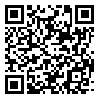1. Jolliet P, Chevrolet JC. Bronchoscopy in the intensive care unite. Intensive Care Med 1992; 18:160-169. DOI:10.1007/BF01709240
2. Davoudi M, Colt H. Bronchoscopy simulation: a brief review. Adv in Health Sci Educ. 2009; 14(2): 287-296. DOI: 10.1007/s10459-007-9095-x
3. Mason RA. Education and training in airway management. Br J Anaesth 1998; 81:305-379.
4. Randell T, Hakala P. Fiberoptic intubation and brochofibroscopy in anaesthesia and intensive care. Acta Anaesthesiol Scand 1995; 39(1):3-16.
5. Marsland CP, Robinson BJ, Chitty CH, Guy BJ. Acquisition and maintenance of endoscopic skills: developing an endoscopic dexterity training system for anesthesiologists. J Clin Anesth 2002; 14: 615-619.
6. Bainton CR. Models to facilitate the learning of fiberoptic technique.Int Anesthesiol Clin 1994; 32:47-55.
7. Azizi F,[Medical education in Iran; past, now and future].Journal of Medical Education Fall 2003 4(1); 43-45. [Persian]
8. World Federation for Medical Education (WFME). Basic Medical Education. WFME Global Standards for Quality Improvement. Copenhagen, Denmark: WFME Office; 2003.
9. Ruiz GJ, Mintzer MJ, Leipzig RM. The Impact of E-Learning in Medical Education. Acad Med 2006; 81(3):207-212.
10. Khan BH. People, process and product continuum in e-learning: The e-learning P3 model. Educ Technol 2004; 44:33-40.
11. Kohn L, Corrigan J, Donaldson M. To Err Is Human: Building a Safer Health System.National Academies Press (US); 2000.
12. Strangman N&HT. Virtual Reality/Simulations. National Center on Accessing the General Curriculum 2003.
13. Mario A, Gutiérrez A, Vexo F, Thalmann D. Stepping into Virtual Reality.1st ed Verlag London: Springer: 2008.
14. Seymour NE, Gallagher AG, Roman SA, O›Brien MK, Bansal VK, Andersen DK, et al.Virtual Reality Training Improves Operating Room Performance: Results of a Randomized,Double-Blinded Study. Annals of Surgery 2002; 236 (4): 458 –464
15. Chakravarthy B. Medical simulation in EM training and beyond. Newslett Soc Acad Resid 2006 Jan 1.
16. Kincaid J, Hamilton R, Tarr R, Sangani H. Simulation in education and training. In Obaidat MS, et al (eds) . Applied system simulation: methodologies and applications Kluwer Academic Publishers; 2003. p. 437-56.
17. Salas E, Cannon-Bowers JA. The science of training: a decade of progress. Annu Rev Psychol 2001; 52:471-99.
18. Jacqueline Jeffrey. Medical Simulation: A Growing Medical Teaching Method and Field of Research. Journal of Hospital Librarianship 2007; 7(4):105-111.
19. Department of Computer Science . Stony Brook University. 3D Virtual Colonoscopy - Publications Visualization lab.Available from: https://labs.cs.sunysb.edu/labs/vislab/3d-vir tual-colonoscopy-home/
20. Domenico S, Simonassi C, Chessa L. Inexpensive anatomical trainer for bronchoscopy. Interactive Cardiovascular and Thoracic Surgery 2007;6(4):567-9. DOI:10.1510/icvts.2007.153601
21. Mohajery SM, Mohajery SA. Simulation and virtual reality, a new approach for improvement of educational quality. Horizons of Medical Education Development. 2010; 4(1): 69-74.
22. Colt HG, Crawford SW, Galbraith O. Virtual reality bronchoscopy simulation: A revolution in procedural training. Chest 2001; 120 (4):1333-1339.
23. Swenty CF, Eggleston BM. The Evaluation of Simulation in a Baccalaureate Nursing Program.Clinical Simulation in Nursing 2011; 7 (5): e181-e187. DOI: http://dx.doi.org/10.1016/j.ecns.2010.02.006
24. Hermanns M, Lilly ML, Crawley B. Using Clinical Simulation to Enhance Psychiatric Nursing Training of Baccalaureate Students. Clinical Simulation in Nursing 2011;7(2): e41-e46. DOI:http://dx.doi.org/10.1016/j.ecns.2010.05.001
25. DeBourgh GA, Prion SK. Using Simulation to Teach Prelicensure Nursing Students to Minimize Patient Risk and Harm. Clinical Simulation in Nursing 2011; 7 (2): e47–e56. DOI:http://dx.doi.org/10.1016/j.ecns.2009.12.009
26. McKeon LM, Norris T, Cardell B, Britt T. Developing patient-centered care competencies among prelicensure nursing students using simulation. J Nurs Educ 2009; 48 (12): 711-5.
27. Sears K, Goldsworthy S, Goodman WM. The relationship between simulation in nursing education and medication safety. J Nurs Educ 2010; 49 (1): 52-5.
28. McNeil J, Pawlowski J. Bronchoscopy Simulation in Anesthesia Resident Education. Open Journal of Anesthesiology 2013; 3(3): 173-175. DOI: 10.4236/ojanes.2013.33041




